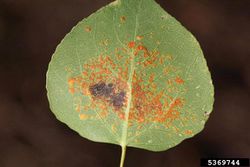Melampsora medusae
| Literature database |
|---|
| 25 articles sorted by: |
| • year (recent ones first) |
| • research topics |
| • countries/regions |
| • host plants |

Author(s): Whitney Cranshaw, Colorado State University
Source: IPM Images
Melampsora medusae Thüm. 1878
This fungus is believed to have originated from North America, but is now widely distributed. It is one of several Melampsora species causing poplar rust (e.g. see also Melampsora larici-populina and Melampsora allii-populina). Some of these species have been identified as hybrids. Poplar rust can lead to premature defoliation and reduced tree growth. Repeated severe infections can be very destructive, especially to young trees, causing dieback and in severe cases even tree death. Attempts are under way to identify poplar cultivars that are resistant to this fungus.
M. medusae forms yellow to orange uredinia on the lower surface of poplar leaves. The urediniospores are airborne and can initiate several disease cycles on poplar during the summer. In autumn brownish black telia and teliospores are produced that overwinter. During spring the teliospores germinate and form basidiospores which infect Larix and other conifers producing spermogonia and later yellowish aecia. The aeciospores infect poplar species again.
Several formae speciales of M. medusae have been described that infect only specific Populus species. Some of these forms have a restricted geographical distribution.
For a review and diagnostic guidance see the EPPO Bulletin (2009).